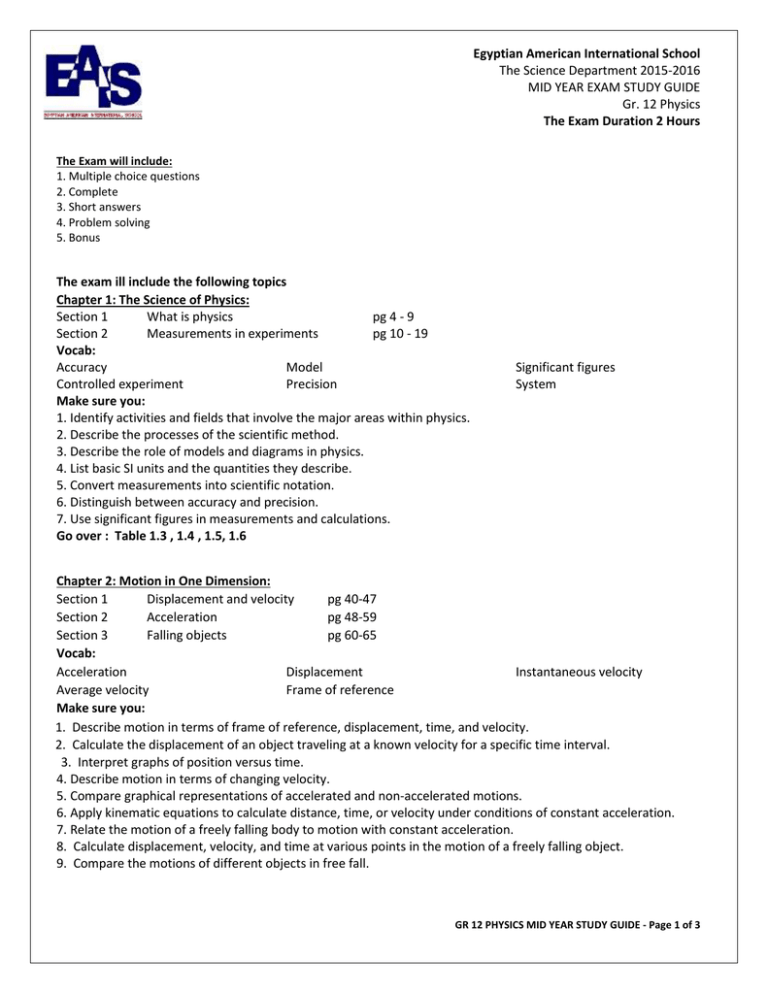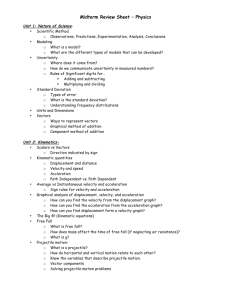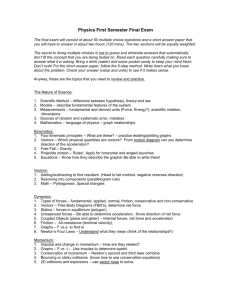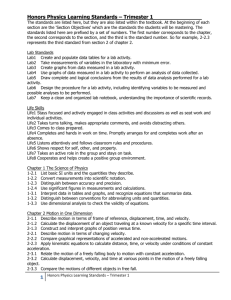Egyptian American International School The Science Department
advertisement

Egyptian American International School The Science Department 2015-2016 MID YEAR EXAM STUDY GUIDE Gr. 12 Physics The Exam Duration 2 Hours The Exam will include: 1. Multiple choice questions 2. Complete 3. Short answers 4. Problem solving 5. Bonus The exam ill include the following topics Chapter 1: The Science of Physics: Section 1 What is physics pg 4 - 9 Section 2 Measurements in experiments pg 10 - 19 Vocab: Accuracy Model Controlled experiment Precision Make sure you: 1. Identify activities and fields that involve the major areas within physics. 2. Describe the processes of the scientific method. 3. Describe the role of models and diagrams in physics. 4. List basic SI units and the quantities they describe. 5. Convert measurements into scientific notation. 6. Distinguish between accuracy and precision. 7. Use significant figures in measurements and calculations. Go over : Table 1.3 , 1.4 , 1.5, 1.6 Significant figures System Chapter 2: Motion in One Dimension: Section 1 Displacement and velocity pg 40-47 Section 2 Acceleration pg 48-59 Section 3 Falling objects pg 60-65 Vocab: Acceleration Displacement Instantaneous velocity Average velocity Frame of reference Make sure you: 1. Describe motion in terms of frame of reference, displacement, time, and velocity. 2. Calculate the displacement of an object traveling at a known velocity for a specific time interval. 3. Interpret graphs of position versus time. 4. Describe motion in terms of changing velocity. 5. Compare graphical representations of accelerated and non-accelerated motions. 6. Apply kinematic equations to calculate distance, time, or velocity under conditions of constant acceleration. 7. Relate the motion of a freely falling body to motion with constant acceleration. 8. Calculate displacement, velocity, and time at various points in the motion of a freely falling object. 9. Compare the motions of different objects in free fall. GR 12 PHYSICS MID YEAR STUDY GUIDE - Page 1 of 3 Chapter 3: Two-dimensional motion and Vectors : 3.1 Introduction to vectors pg 84-87 3.2 Vector operations pg 88-97 3.3 Projectile motion pg 89-105 3.4 Relative motion pg 106-109 Vocab : Components of a vector Resultant Vector Projectile motion Scalar Make sure you: 1. Distinguish between a scalar and a vector. 2. Identify appropriate coordinate systems for solving problems with vectors. 3. Apply the Pythagorean Theorem and tangent function to calculate the magnitude and direction of a resultant vector. 4. Resolve vectors into components using the sine and cosine functions. 5. Add vectors that are not perpendicular. 6. Recognize examples of projectile motion. 7. Describe the path of a projectile as a parabola. 8. Resolve vectors into their components and apply the kinematic equations to solve problems involving projectile motion. Chapter 4: Forces and the Laws of Motion : 4.1 Changes in motion pg 124-128 4.2 Newton’s first Law pg 130-135 4.3 Newton’s second and third Laws pg 136-140 4.4 Everyday Forces pg 141-145 Vocab: Action-reaction pair Force, Normal force Coefficient of friction Force diagram Static friction Contact force Inertia Weight Equilibrium Kinetic friction Field force Net external force Make sure you: 1. Describe how force affects the motion of an object. 2. Interpret and construct free-body diagrams 3. Explain the relationship between the motion of an object and the net external force acting on the object. 4. Determine the net external force on an object. 5. Calculate the force required to bring an object into equilibrium. 6. Describe an object’s acceleration in terms of its mass and the net force acting on it. 7. Predict the direction and magnitude of the acceleration caused by a known net force. 8. Identify action-reaction pairs. 9. Explain the difference between mass and weight. 10. Find the direction and magnitude of normal forces. 11. Describe air resistance as a form of friction. 12. Use coefficients of friction to calculate frictional force GR 12 PHYSICS MID YEAR STUDY GUIDE - Page 2 of 3 Chapter 6: Momentum and collisions: 6.1 Momentum and Impulse pg 208-214 6.2 Conservation of momentum pg 215-221 6.3 Elastic and inelastic collisions pg 222-230 Vocab: Elastic collision Momentum Impulse Perfectly inelastic collision Make sure you : 1. Compare the momentum of different moving objects. 2. Compare the momentum of the same object moving with different velocities. 3. Identify examples of change in the momentum of an object. 4. Describe changes in momentum in terms of force and time. 5. Describe the interaction between two objects in terms of the change in momentum of each object. 6. Compare the total momentum of two objects before and after they interact. 7. State the law of conservation of momentum. 8. Predict the final velocities of objects after collisions, given the initial velocities. 9. Identify different types of collisions. 10. Determine the changes in kinetic energy during perfectly inelastic collisions. 11. Compare conservation of momentum and conservation of kinetic energy in perfectly inelastic and elastic collisions. 12. Find the final velocity of an object in perfectly inelastic and elastic collisions Please make sure you study all section reviews, all problem practices in the textbook, go over all quizzes and tests and extra sheets. It is also very important that you read your textbook. GR 12 PHYSICS MID YEAR STUDY GUIDE - Page 3 of 3







